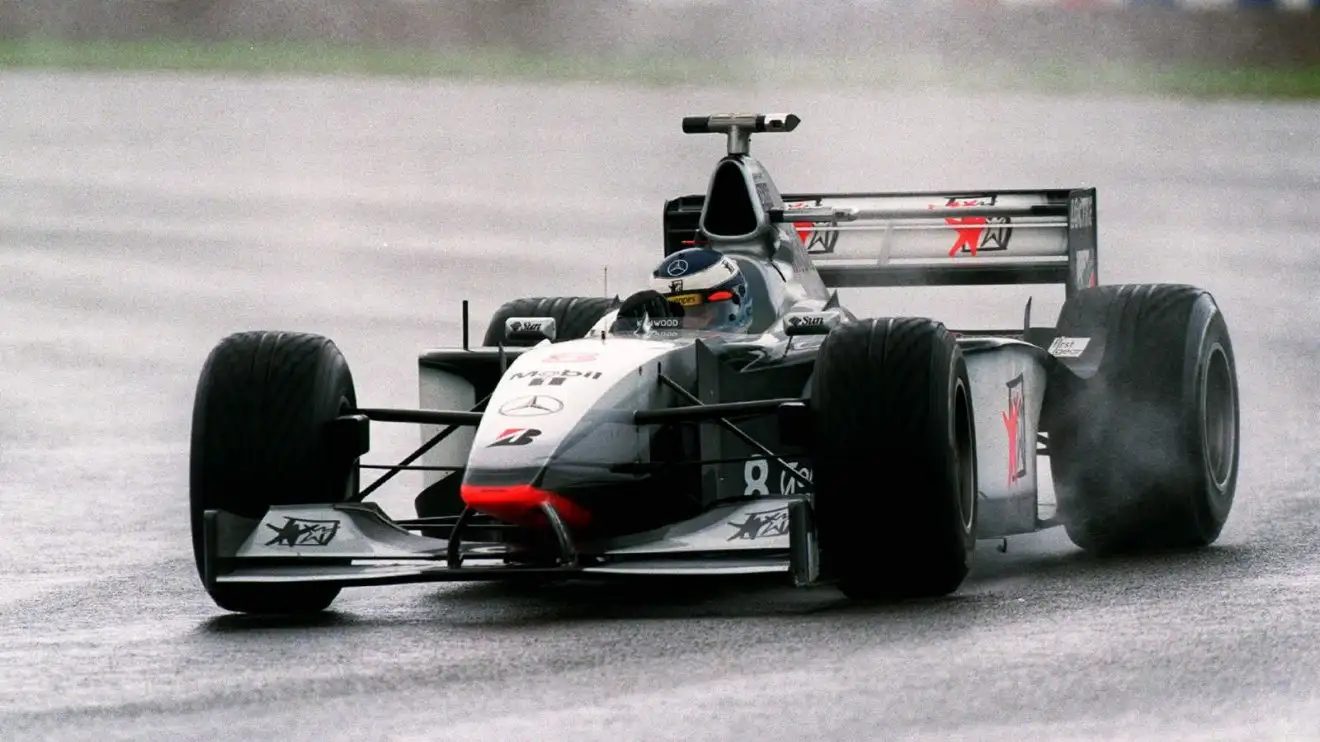
In 1998, McLaren fell foul of an in-season rules change as the FIA clamped down on the team’s ‘fiddle brake’, which was discovered by an eagle-eyed photographer. A cunning (and cheap!) slice of ingenuity created by McLaren in 1997 was banned in early ’98, just as its MP4/13 had begun life in dominant fashion, with a second brake pedal having been discovered in the cockpit. In 1997, McLaren came up with the idea for a unique brake-steer system, later dubbed a ‘fiddle brake’ by Ferrari ‘s Ross Brawn, in which the drivers could brake just one of the rear wheels at a time, reducing understeer dramatically.
It was a simple concept, with the independently operated rear brakes allowing the drivers to get back on the power earlier while continuing to brake the appropriate wheel behind them, but it was quickly discovered – although not by the FIA. McLaren told the story of the controversial technology on its website in 2017, where McLaren’s chief engineer Steve Nichols recounted how the idea came about. “I had this idea to put a rear brake on in the corners, to sort of dial out the understeer,” he said, speaking about the 1997 MP4/12.
“Paddy Lowe was head of R&D at the time, and this would be considered an R&D project. So I told him I wanted to try this thing where we have an extra pedal in the car, and we put the right-rear or left-rear brake on to balance the car. Eventually, he sanctioned the project.
It sat on the test truck for months waiting to be tested, and finally, we’d exhausted every other test item. At 5 pm or something, at a Silverstone test, they said let’s try that brake thing!” Chief test team engineer Tim Goss said that, on the regulation side, McLaren was confident of the legality of the braking system, and that it had been a very easy idea to implement as an extra master cylinder and a length of brake hose was fitted to a single caliper – the driver would then activate the system by swapping over to the extra brake pedal at his feet after using the normal brakes to slow the car for a corner. Race driver David Coulthard initially was against the idea, believing it to be “weird”, but Mika Hakkinen was up for trying out the system and, according to Nichols, it was a straight-forward addition of a pedal in the pedal box for the Finn as he was a left-foot braker.
Almost instantly, Hakkinen went half a second quicker, even with the system only set up for a rudimentary experiment – meaning more work would be put into refining the system. With Coulthard struggling to use a hand clutch, the Scot required a fourth brake pedal as McLaren began using the system for Grand Prix weekends. While starting to realise its potential, the Woking-based squad was still only at the point of being able to run the system braking one caliper at a time – selecting which rear brake caliper to link to the extra caliper based on the characteristics of each circuit on the calendar.
“We were racing with it on just one side,” Goss explained. “So we’d pick which side we’d want to do, biased mainly to long high-speed corners where we had understeer. As you applied the brake mid-corner it would brake one of the rear wheels, and as you didn’t want to slow the car down, you’d open the throttle to compensate.
“As the drivers got more used to it they could drive the thing harder and harder, which reduced the understeer. You had the added benefit that you didn’t have to carry so much front wing on corner entry, so you ended up with a more stable car.” Picking up the story, Coulthard said it required both he and Hakkinen to figure out how to drive a bit differently.
“We had to learn how to work with it because you had to accelerate while you braked, otherwise you just locked the wheel,” he said. “You could feel it was an advantage because it yawed the car. So instead of riding over the front tyre, you could rotate the car without having to put steering lock on.
“And steering lock affects the aerodynamics quite a lot, so there was an advantage aerodynamically in having that. We could use it also to control a bit of wheel-spin on the inside wheel, coming out of tight corners. Independently, Mika and I both worked that out.
The theory had been proven in tanks and things like that, but actually doing it at speed out on the track was always going to be a bit different!” McLaren, who didn’t have the most competitive season in 1997, showed great flashes of speed in the latter half of the season, particularly after the system was introduced. For instance, in Austria, Mika Hakkinen was less than a tenth off pole position on the front row, but unreliability meant he couldn’t turn his first-lap lead into a significant result. At the following race, at the Nurburgring, Hakkinen did take pole and McLaren led with a 1-2 early on, only for both to retire with mechanical issues.
But these performances had already begun to pique media interest and it was only a matter of time until someone figured out what McLaren was up to. F1 Racing magazine photographer Darren Heath, going through his photos from the Austrian Grand Prix, spotted that a rear brake disc on the McLaren was glowing – indicating brake application – at a point where the drivers shouldn’t be braking, such as accelerating out of corners. Brainstorming with his colleague and editor Matt Bishop – later to work with McLaren’s communications department – Heath came up with the idea of an extra brake, but how to prove such a system was in place? This meant trying to get near the McLaren and looking inside the cockpit.
With both retiring at the Nurburgring, McLaren’s woes were to be added to as Heath approached the cars behind the barriers to attempt to get photos of the footwells. Coulthard had left his steering wheel on, blocking Heath from getting the shot he wanted, but Hakkinen’s steering wheel-less car gave the photographer enough room to place his camera inside and get the decisive image that proved the existence of an additional pedal. The images Heath captured, and the resulting story, was F1 Racing’s big scoop for its November 1997 edition – the hidden brake system had been rumbled just two races after being introduced.
With the existence of the system becoming public, chief designer Neil Oatley remembered how discussions with the FIA began to play out. “We didn’t check the system’s legality with the FIA before racing it because we never thought there was any question about it,” he said, as quoted by Motorsport Magazine. “It came to light at the Austrian GP, I think, when some pictures of the car showed the inside rear disc glowing and not the front disc.
That alerted people. “Then, at the Nurburgring, both our cars had failures and stopped just past the pits. A photographer took a picture inside the cockpit of our pedal arrangement.
The FIA looked at the system and couldn’t see any reason for us not to use it, so we continued to for the rest of that year.” McLaren finished fourth in the Constructors’ Championship in what had been a modestly competitive season, with its 1-2 finish at the season finale at Jerez coming about as Jacques Villeneuve and Michael Schumacher collided in their infamous title decider. But the hullabaloo over McLaren’s brake system would really kick off in early 1998 as the MP4/13 was an entirely different animal.
👉 Explained: How the FIA develops potential new F1 rules and regulations 👉 F-Duct uncovered: The banned McLaren innovation that gave birth to DRS McLaren had signed famed designer Adrian Newey as technical director for 1998, with the British engineer overseeing the first car designed to the new narrow-body regulations. The innovative fiddle brake was included as part of the original concept, with a switchable system designed onto the car to allow the drivers to switch between the left and right rear brake caliper offering an advantage for every corner at every circuit. At the season opener in Australia, Hakkinen and Coulthard were untouchable.
Taking first and second on the starting grid, the duo lapped every single other car – that was despite a little bit of intra-team drama as Coulthard ceded position to Hakkinen following an erroneous pitstop from the Finn. Yes, you’ve read that correctly. McLaren lapped the field, despite Hakkinen driving through the pits unnecessarily and Coulthard then slowing down to let him back through.
Unsurprisingly, this dominance resulted in drama as Ferrari lodged a protest over the braking system on the MP4/13 ahead of the Brazilian Grand Prix. The discussions focused on whether or not the system was a steering device or a braking device, given the drivers were able to apply the brakes on the rear wheels independently – the assist on turning and traction being the primary use of the system, rather than the braking itself. With the stewards ruling the system could be viewed as illegal for Brazil, McLaren didn’t use it at Interlagos – but still produced a 1-2 finish and a minute ahead of Michael Schumacher’s Ferrari.
“The system was remarkably powerful,” Newey said of the fiddle brake system. “Its worth was circuit-dependent, obviously, but, on average, I would say it was worth 0.3sec per lap – that’s probably conservative, actually.
“The biggest effect on set-up was that you could run the car more ‘understeery’, more stable, so that you were less likely to have entry oversteer problems. And you could have better traction because you’d set the car up more towards understeer.” “Nobody cottoned on to what we were doing,” Nichols explained.
“Williams punted something into Charlie Whiting [of the FIA] that was all electronically controlled where they would turn off all the brakes except say the right rear, and just apply that one. And Charlie immediately said, ‘No, I think that’s going to be kind of unsafe!’ “Various people were putting in various proposals. Ferrari claimed it was four-wheel steering, they sent the FIA pictures of tanks where they brake one track and that’s how they steer, but they still didn’t know what we were doing.
” Once the rival teams had figured out exactly what McLaren was up to, the FIA moved to ban the system, much to team boss Ron Dennis’ chagrin as the system had been decreed as legal over the winter during discussions with the FIA and Whiting. “It was banned on the basis of four-wheel steering although, obviously, it was not realigning the wheels,” Goss explained. “We called it brake-steer, which was unfortunate when we tried to argue that it wasn’t anything to do with steering! It was a bad choice of name from ourselves.
Then Ross Brawn coined the term “fiddle-brake” which is used by cross-country trial cars for a handbrake that works on each of the rear wheels to try and turn the car.” While McLaren’s system was undoubtedly simply a brake, the fact that its intended use couldn’t be argued to be primarily used for braking and was, instead, a steering aid, resulted in the grounds for the FIA to ban it. To tighten up the wording of the technical regulations, the FIA refined Article 10.
4.1 from “ Four-wheel steering is not permitted,” to “Any steering system which permits the re-alignment of more than two wheels is not permitted.” Article 11.
1 of the 1998 Technical Regulations is amusingly simplistic compared to its 1999 iteration. The 1998 wording simply states: “ All cars must have a brake system which has at least two separate circuits operated by the same pedal. This system must be designed so that if leakage or failure occurs in one circuit, the pedal shall still operate the brakes on at least two wheels.
” Realising this wasn’t prescriptive enough in what was permitted on the braking system, the 1999 regulations for the same Article are as follows: 11.1.1 All cars must be equipped with one brake system which has two separate hydraulic circuits operated by one pedal, one circuit operating on the two front wheels and the other on the two rear wheels.
This system must be designed so that if a failure occurs in one circuit the pedal will still operate the brakes in the other. 11.1.
2 The brake system must be designed in order that brake caliper pressures in each circuit are the same at all times. 11.1.
3 Any powered device which is capable of altering the configuration of the brake system whilst it is under pressure is forbidden. 11.1.
4 Any change to, or modulation of, the brake system whilst the car is moving must be made by the drivers direct physical input, may not be pre-set and must be under his complete control at all times. Other teams had complained about the cost of developing such a system, part of the factor in the decision to ban it, which was a source of amusement for McLaren as the initial version had been cobbled together with some spare parts in the back of their test truck. “I remember Alain Prost, who had a team at the time, saying we’ve got to ban this because it will cost millions in development,” Nichols said.
“And it was fifty quid’s worth of parts that we already had in the truck!” Newey, who hadn’t been part of McLaren in the early days of the idea, was nonetheless left frustrated by what he saw as indecisiveness from the governing body over the legality of the system. “The issue of who decides the legality of technical innovations in F1 was never settled; if anything the opposite,” he said. “It was the first of a whole host of examples where the FIA has said that in its opinion something is legal, so you build it and race it, then someone else says that in their opinion it isn’t, and you have to take it off again.
“Which is quite a frustrating business, as you can imagine. I have sympathy with the FIA because it is possible for a team to try to hoodwink it. But the net result is that teams sometimes spend a load of money in the belief that something is OK, only to find that it is subsequently banned.
” Read Next: Ranking Fernando Alonso’s F1 career moves from worst to best.














